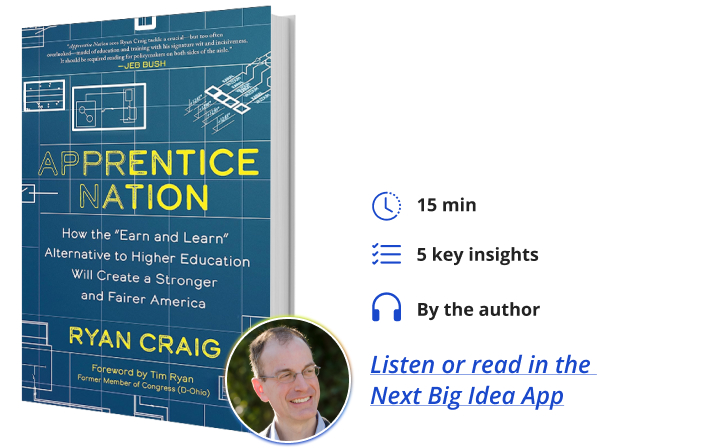Ryan Craig is a managing director at Achieve Partners, a venture capital and private equity firm. Ryan’s commentary regularly appears in the biweekly Gap Letter, Forbes, and Inside Higher Education. Ryan is a co-founder of Apprenticeships for America, a national nonprofit dedicated to scaling apprenticeships across the U.S. economy. Previously, he led the education and training sector at Warburg Pincus. His prior experience in higher education was at Columbia University and he began his career at McKinsey & Co.
Below, Ryan shares five key insights from his new book, Apprentice Nation: How the “Earn and Learn” Alternative to Higher Education Will Create a Stronger and Fairer America. Listen to the audio version—read by Ryan himself—in the Next Big Idea App.

1. College graduates are facing a crisis of employability.
The song of the summer was undoubtedly “Rich Men North of Richmond,” a song by new singer-songwriter Oliver Anthony. In the lyrics, Anthony sings “I’ve been selling my soul working all day, over time hours for bullshit pay. Young men are putting themselves six feet in the ground because all this damn country does is keep on kicking them down.”
While conservatives tried to appropriate Rich Men North of Richmond as a conservative anthem, the songwriter was unapologetic. It’s not Democrat, Republican, conservative, or liberal. This is a song about young people who are on the outside and having a hell of a time trying to make their way in. One reason for that is that college isn’t as working as well as we’d like in terms of launching careers.
It’s not unemployment because these college graduates aren’t getting jobs, but rather underemployment, meaning they’re taking jobs they could have gotten without a degree or that don’t require the skills they gained in college. Underemployed college graduates earn $10,000 less on average per year than other graduates, and if they’re underemployed, two-thirds of them remain underemployed five years later and half are underemployed 10 years later.
One reason for that is that college is continuing to train for the good jobs of the last century. Think about Mad Men or LA Law; these jobs didn’t require any specific skills. They required a broad set of skills but once people were in the job, they began to learn the skills they needed.
The skills that employers are looking for today are very different. Employers are seeking a set of skills that include specific digital or platform skills. Think about Salesforce or Workday, Oracle, and cyber security. These are things that colleges and universities don’t teach by and large, but that employers increasingly insist on in job descriptions.
“What’s missing is a clear alternative that America can rally around.”
Colleges are closed off from the real economy by the terms of academic programs. These programs are developed by people in the same field with PhDs, many of whom have never worked outside of academia. Colleges also close themselves off in terms of their focus on rankings. They also lack accountability. University boards that graduate these students never know or understand what employment outcomes are out there for graduates. Accreditors for these students also don’t take into account the employability of their loanees.
As a result, undergraduate enrollment has declined almost 10 percent over the last two years, and colleges have faced a dramatic loss of political support, particularly on the right. Nevertheless, governments are continuing to throw money at colleges and universities. The Biden administration is going to spend almost $500 billion to make income-driven student loan repayment more generous.
And although the Supreme Court struck down the administration’s first effort to forgive student loans broadly, the government is continuing to pursue blanket student loan forgiveness. Meanwhile, states continue to increase funding for their systems. Last year, California added another $600 million. What’s missing is a clear alternative that America can rally around.
2. Apprenticeship is the obvious alternative.
Apprenticeship is the only alternative that truly levels the playing field for people from all backgrounds. Why? Because an apprenticeship is a full-time job that pays a living wage from day one, and that has formal instruction called related technical instruction. Technical instruction is a classroom instruction component of apprenticeships that has on-the-job training, pay increase opportunities, and clear career paths.
Apprenticeships have fantastic returns on investments for workers, governments, and employers. Apprenticeships train on the skills that employers are having a very hard time finding. The digital skills, platform skills, Salesforce and Workday skills are much harder to learn in a classroom than they are by doing.
In addition, apprenticeships close the skills gap, and also the experience gap. The experience gap is becoming even more important than the skills gap in many professions, as employers are insisting on experience before hiring entry-level workers. This turns entry-level jobs into an oxymoron in many cases.
If you look across entry-level job descriptions, the average amount of experience needed for these entry-level jobs can be three months, six months, a year, or more. Almost 40 percent of entry-level jobs, according to a recent survey, are asking for the equivalent of at least three years of experience. That’s the experience gap, and it’s about to be widened by artificial intelligence.
Think about the entry-level job that you did in your first good job. Much of the work you did was probably fairly menial basic work that you completed as you learned the industry. In this job, you learned how to do the job, and only some of the work required real skills or experience. Much of that menial work, if not all of it, is going to be done by AI in a few years, and employers are going to expect that entry-level workers off the bat are going to be able to do skilled work that is going to require real experience in order to do the job.
3. America is far behind every other developed country on apprenticeship.
When we think of apprenticeship in America, we probably think about plumbers, electricians, or roofers, and there’s a good reason for that. Currently, 70 percent of the apprenticeships working in America are in the construction trades.
There are about 500,000 apprentices currently in the U.S., which sounds like a lot, but only represents 0.3 percent of the workforce. Other countries do much better. In fact, the U.S. is at the bottom of the apprenticeship tables among developed countries. Germany, Austria, and Switzerland do 10 to 15 times better. The UK, Australia, Canada, and France do eight times better and apprenticeships in those countries aren’t just in construction. They’re spread across the economy in financial services, tech, healthcare, and logistics.
“The U.S. is at the bottom of the apprenticeship tables among developed countries.”
Why are we so far behind? First, take a look at what it actually takes to launch an apprenticeship program. For an employer to launch an apprenticeship program, they have to do about 10 things that they’re not currently doing. They have to hire or assign someone to run the program. They have to recruit and screen high-potential talent. They have to develop an on-the-job training component of the program. They have to develop classroom-based instruction, real-time information, and they have to deliver this real-time information. They have to pay for training. They have to assign or pay mentors. They have to administer the program. If it’s going to be a registered program with the Department of Labor, they have to take care of registering it.
Most importantly, they have to be willing to hire apprentices and pay them before they’re productive, and that’s antithetical for most employers. Most employers only want to hire a worker if they know they can be productive pretty much from the get-go. Are most employers willing to launch apprenticeship programs themselves? No. One lesson we learned from looking internationally is that where apprenticeships flourish, they flourish because intermediaries do most of the work of organizing or operating these programs. In the U.S., the construction trades unions play this role.
4. Other countries have already figured out their system.
Most people who look abroad for lessons on apprenticeships will travel to Germany. It seems like almost every other month there’s a delegation from a state going over to Germany to drink Riesling, eat schnitzel, and take a look at German apprenticeships.
What they find when they go is that we can’t replicate what they’ve done. We can’t replicate what they’ve done because the role of intermediaries is performed by chambers of commerce and powerful unions whose role in setting up and running these programs on behalf of employers is actually written into law. They’re required to do it and the funding and the skills frameworks are baked in as well.
Looking to the UK and Australia is far more productive for us. About 30 years ago, both of those countries looked a lot like the U.S.: small apprenticeship sectors, almost all in construction. But today, those apprenticeship sectors flourish and scale across the economy. Those countries don’t have comparable chambers of commerce or unions, but they do provide ample funding for apprenticeship programs. They created funding on a formula basis, so there was funding for every apprentice who got hired and placed. As a result, today in those countries, there’s a robust ecosystem of intermediaries. These intermediaries knock on the doors of every large or mid-sized company and offer to set up and run apprenticeship programs for them.
That just simply doesn’t happen in the U.S.. In the U.S., we’re intermediary poor because we’ve done a poor job of funding it. One reason is the amount of funding we are providing. In the U.S., governments spend over $500 billion a year subsidizing accredited colleges and universities. Compare that to what we spent on apprenticeships—around $400 million—which is over a thousand-to-one ratio. For every dollar of public support that an apprentice receives, a college student receives fifty dollars. I don’t know if the ratio should be one-to-one, two-to-one, or 10-to-one, but surely it shouldn’t be 50-to-one or 1,000-to-one. We are way out of balance in terms of how we’re funding career launch.
The second reason that apprenticeships don’t happen in the U.S. is because they are not funded correctly. Even though we are spending more on apprenticeships now than in the past, the Department of Labor is using grants to pick “winners” or intermediaries. In picking intermediaries who would create apprenticeship programs, the DOL doesn’t recognize the difference between programs that do most or just some of the work that employers would otherwise need to do. As a result, almost all of DOL funding has gone to “low intervention intermediaries” like community colleges, which leave most of the work to employers, who respectfully decline.
“We’re intermediary poor because we’ve done a poor job of funding it.”
What should we be doing? We should be fully funding apprenticeships like all our competitors. We should also be shifting from grants to formula funding, such as a “pay per apprentice” program, which naturally advantages higher intervention or higher value intermediaries.
Formula funding is predictable. It’s what built America’s college system. Think about colleges and universities. The money travels with the student. The money should also travel with apprentices. We should be paying employers and intermediaries who hire and train apprentices. Apprenticeship may be the only education or workforce issue Democrats and Republicans agree on.
5. An apprenticeship nation rethinks the American dream.
As an apprentice nation, we’d have intermediaries knocking on employer doors in every market, yielding tens of thousands of new apprenticeship programs in tech, healthcare, financial services, and so forth. They would be registered apprenticeship programs. We’d have a federal database or directory of apprenticeship programs that actually hire apprentices in each sector of the economy, and guidance counselors in high schools could rely on that database to directly send students to apprenticeship programs in the same way they’re sending them to colleges and universities today.
My vision of an apprentice nation has as many large-scale apprenticeship programs as we have colleges and universities. Having an apprentice nation would solve a big problem that’s contributing to the challenges facing higher education. That problem is referred to as “information asymmetry.” Information asymmetry happens when colleges know or ought to know what programs are not producing good outcomes for students who enroll. The individual students also remain uninformed about where their degrees will take them, meaning that they potentially waste their time and money.
Think about shopping for used cars. People used to make millions of bad decisions because they didn’t know what they were looking at. That was prior to the Lemon Law, which determined whether or not a car was reliable. Today, there are laws at the state level that require dealers to disclose information about their cars. We need the same thing for colleges and universities, and the best way to do that is to change the order in which a career launch occurs.
Today, we go from high school to college to work. But millions of young people would do better if they went from high school to work to college. They would gain work experience, they’d gain confidence that they’re able to support themselves, they’d gain soft skills and they’d gain insights on their own interests and strengths. The best way to do that is through apprenticeship. There’d be more of a fair information fight.
Apprenticeships aren’t the only way to do this. You can do it through internships, you can do it through work-integrated learning, but they’re the best way to do it. Becoming an apprentice nation will mean renewing the American dream. Unique among education and workforce development models, apprenticeships have the potential to unify the country. There may be no other way to reach dislocated and disaffected Americans who don’t want a handout. They want work, but not dead-end work. They want work with an opportunity for advancement.
When apprenticeship programs are found in every region of the country, providing paid points of entry into tech, healthcare, financial services, and other fast-growing sectors, education will look different. It will be nation-altering and perhaps nation-saving.
To listen to the audio version read by author Ryan Craig, download the Next Big Idea App today:





























